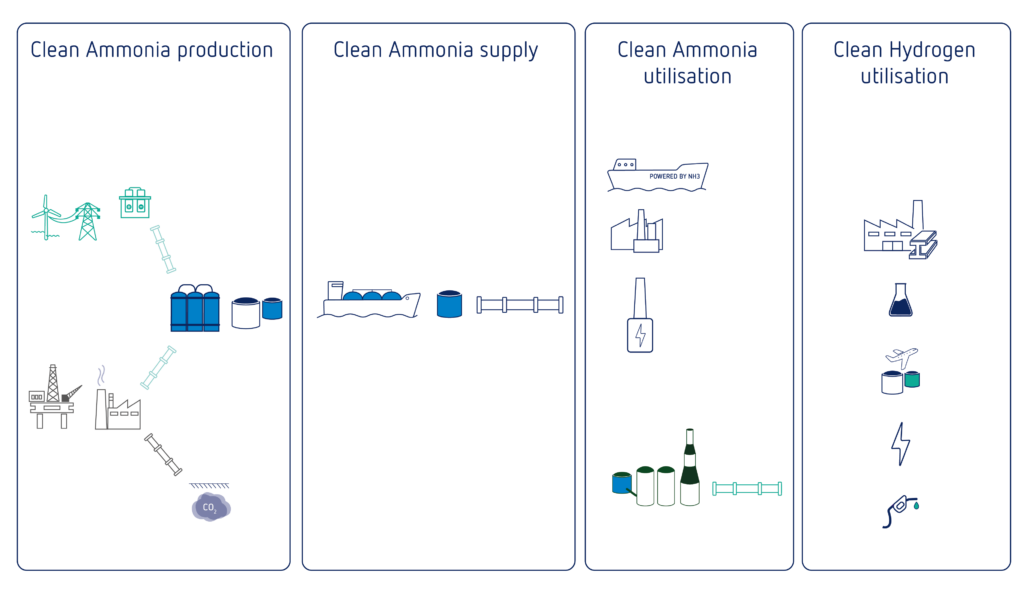As the Paris Agreement aims to achieve net zero emissions in the second half of this century, the Dutch government has set a goal to phase out fossil fuels within the upcoming decades. Within this transition, ammonia has recently emerged as a promising molecule. Although readily used as a commodity, there might be a new role for ammonia as a marine fuel or as a key energy vector in the hydrogen economy.
As the role of ammonia within the energy- and material transition is fairly new, the Clean Ammonia Platform brings together stakeholders to address both technical, economical and societal questions that will help to form the future landscape for clean ammonia. In this threefold story our network of experts across the value chain exchanged knowledge and discussed key opportunities and challenges. In this article, we talked to Albert Lanser (Duiker Clean Technologies), Simone van Tongeren (Deltalinqs), Jan-Jaap Nusselder (OCI Global) and Rob Stevens (ISPT) on the emergence of ammonia in both the energy- and material transition.
The new key role of ammonia in the energy- and material transition
“Ammonia itself is not an unknown chemical. It already figures as an essential global commodity, primarily utilized as feedstock for fertilizers in the agricultural sector, or as a building block in the chemical industry. This means that the advantages of ammonia are already well-documented and widely recognized,” states Jan Jaap Nusselder (OCI Global). “However, with the prospects of moving towards a more sustainable society, interest has shifted: uncovering the potential of ammonia in our future energy system.”
“Its potential is rooted in the numerous advantages of ammonia when compared to competing feedstocks and fuels. When ammonia is burned it does not emit carbon dioxide (CO2); its transport and storage capabilities are highly convenient; it boasts a high energy density; it can be used directly in production processes or as a fuel; and ammonia can be cracked and serve as a hydrogen carrier. Consequently, ammonia offers substantial advantages for these new markets,” Jan Jaap Nusselder (OCI Global) continues.
Rob Stevens (ISPT) adds: “Approaching ammonia in this way, the molecule holds the potential to decarbonize industries that are still reliant on fossil fuels. In the upcoming years, ammonia is expected to play a key role as a clean fuel in the maritime sector. And on longer terms, clean ammonia can be utilized as a hydrogen vector helping us to realize the much-anticipated hydrogen economy.”
Ammonia’s market potential
The impact of ammonia on the energy sector can thus be significant. Albert Lanser (Duiker Clean Technologies) explains: “Today, our ambitious net-zero goal mostly depends on wind and solar energy. However, relying solely on the North Sea wind and our solar parks for green energy won’t suffice the energy demand of our industry. This means we’ll remain dependent on other countries for (green) electricity in achieving the climate goals for 2030 and 2050. Leaving the Netherlands facing a significant energy challenge.”
This challenge combined with those of the raw material transition immediately offers opportunities for companies in the port of Rotterdam (and beyond). Simone van Tongeren (Deltalinqs) explains: “The challenge is twofold: green fuels must become available and sustainable sources for the raw material transition must be found. As Deltalinqs, we strive to accelerate the energy and raw material transition by, among other things, transferring the perspective from companies to the government and thus understanding each other and solving barriers together. We see ammonia as a good possible solution for the energy and raw material transition. In this transition it is not a question of either/or, but we should consider all options/pathways/possible solutions.”
This is part 1 in a series of 3 about ammonia:
Part 1 – Ammonia as a new key actor in energy- and material transition
Part 2 – Ammonia’s opportunities for the hydrogen economy
Part 3 – Clean Ammonia: societal benefits, concerns, and safety demands
Opportunities in clean ammonia
“What makes clean ammonia attractive is the fact that the infrastructure for exporting and importing ammonia already exists. Ammonia can therefore easily be imported from areas with an abundance of renewable energy sources to the Netherlands, where sustainable energy is less available,” says Simone van Tongeren. “The facilities of ships, tanks and pipelines for the transportation of ammonia have been in use for many years. This means that the supply chain and logistics infrastructure are already mature and well developed. This allows for possibilities to implement ammonia at large-scale. And given that the Dutch energy goals are approaching quickly, it’s the speed we need now.”
Ammonia can then locally be converted into hydrogen and transported to end users. Which brings us to the innovative solution engineered by Duiker Clean Technologies in this regard. Albert Lanser (Duiker Clean Technologies) explains: “The technology for combustion ammonia whilst maintaining very low NOx emissions readily exists, and we have been using this for years. In traditional oil refinery operations, H2S and ammonia were produced as by-products from the oil desulfurization process. In a plant such as a sulfur recovery unit, we quickly learned how to convert H2S in a useful pure feedstock sulphur and how to combust ammonia completely as this (contaminated) ammonia is considered by refineries as a waste stream. Later, we expanded and developed this patented ammonia combustion technology to other ammonia applications, like ammonia to hydrogen (AHC) and ammonia to heat conversion (A2H).” As a result, Duiker Clean Technologies pioneered the first ammonia combustion technology (SCO) and is now among the few companies worldwide with expertise in burning and cracking ammonia to convert it into hydrogen or into heat. “This experience has led to the reliable and efficient conversion of ammonia, of which the technologies are ready to be applied today in large-scale, industrial environments,” Albert Lanser explains. Due to the increasing volume of hydrogen required to realize the Dutch energy goals, this is likely to become a dominant market for clean ammonia.

Barriers to be addressed
However, while ammonia holds promise as a clean energy solution, there are also understandable concerns that we might be opening Pandora’s box. “Ammonia remains a toxic gas, which requires great care to prevent environmental release,” Jan Jaap Nusselder addresses. Authorities and parties in the value chain are working together to keep the policy framework for storage and transport meeting societal expectations. Ammonia is currently transported safely in The Netherlands via rail and barge. However, there is a lack of understanding and some negative perceptions among the wider public, leading to concerns in social acceptance of ammonia.”
Therefore, the shift towards an ammonia-based energy system leading to higher volume uses, requires thorough understanding of these factors. Updated policy frameworks to ensure safety protocols also need to be supported by greater awareness of the benefits. So, it is of great importance that prominent players in this industry come together to assess opportunities and challenges, giving us insights in how the use of ammonia as an energy carrier can be further developed, and what technical and political developments are needed to shift towards a safe and clean ammonia-based system.
For that reason, ISPT (together with partners) recetly published the Clean Ammonia Roadmap: addressing the various topics related to ammonia as a new key actor in our material- and energy transitions.
Download the Clean Ammonia Roadmap
The industry recognises the potential of using clean ammonia as a low-carbon energy and hydrogen carrier. Although ammonia has been used in chemical industry for nearly 100 years, these new industrial-scale value chains pose new challenges and opportunities. ISPT’s Clean Ammonia Innovation Platform has explored potential market volumes, value chains, and enablers for clean ammonia as an energy and hydrogen carrier. These results are published in the Clean Ammonia Roadmap.
Stay up-to-date on the latest ammonia developments through our LinkedIn-community.
